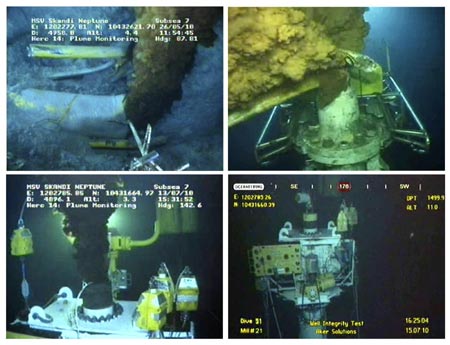World Business
BP finally stops oil spewing from Gulf gusher
(Agencies)
Updated: 2010-07-16 11:03
 |
Large Medium Small |
NEW ORLEANS – The oil has stopped. For now. After 85 days and up to 184 million gallons, BP finally gained control over one of America's biggest environmental catastrophes Thursday by placing a carefully fitted cap over a runaway geyser that has been gushing crude into the Gulf of Mexico since early spring.
Though a temporary fix, the accomplishment was greeted with hope, high expectations — and, in many cases along the beleaguered coastline, disbelief. From one Gulf Coast resident came this: "Hallelujah." And from another: "I got to see it to believe it."
If the cap holds, if the sea floor doesn't crack and if the relief wells being prepared are completed successfully, this could be the beginning of the end for the spill. But that's a lot of ifs, and no one was declaring any sort of victory beyond the moment.
The oil stopped flowing at 3:25 pm EDT when the last of three valves in the 75-ton cap was slowly throttled shut. That set off a 48-hour watch period in which — much like the hours immediately after a surgery — the patient was in stable, guarded condition and being watched closely for complications.
|
||||
Nevertheless, one comforting fact stood out: For the first time since an explosion on the BP-leased Deepwater Horizon oil rig killed 11 workers April 20 and unleashed the spill 5,000 feet beneath the water's surface, no oil was flowing into the Gulf.
US President Barack Obama, who has encouraged, cajoled and outright ordered BP to stop the leak, called Thursday's development "a positive sign." But Obama, whose political standing has taken a hit because of the spill and accusations of government inaction, cautioned that "we're still in the testing phase."
The worst-case scenario would be if the oil forced down into the bedrock ruptured the seafloor irreparably. Leaks deep in the well bore might also be found, which would mean that oil would continue to flow into the Gulf. And there's always the possiblity of another explosion, either from too much pressure or from a previously unknown unstable piece of piping.
The drama that unfolded quietly in the darkness of deep water Thursday was a combination of trial, error, technology and luck. It came after weeks of repeated attempts to stop the oil — everything from robotics to different capping techniques to stuffing the hole with mud and golf balls.
The week leading up to the moment where the oil stopped was a series of fitful starts and setbacks.
Robotic submarines working deep in the ocean removed a busted piece of pipe last weekend, at which point oil flowed unimpeded into the water. That was followed by installation of a connector that sits atop the spewing well bore — and by Monday the 75-ton metal cap, a stack of lines and valves latched onto the busted well.
After that, engineers spent hours creating a map of the rock under the sea floor to spot potential dangers, like gas pockets. They also shut down two ships collecting oil above the sea to get an accurate reading on the pressure in the cap.
As the oil flowed up to the cap, increasing the pressure, two valves were shut off like light switches, and the third dialed down on a dimmer switch until it too was choked off.
And just like that, the oil stopped.
It's not clear yet whether the oil will remain bottled in the cap, or whether BP will choose to use the new device to funnel the crude into four ships on the surface.




